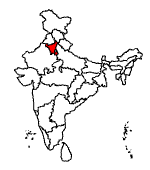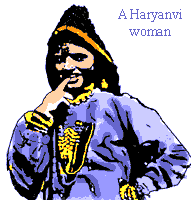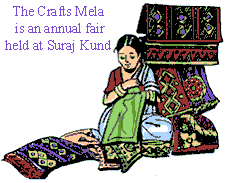
Dimdima
Online Children's Magazine from India

Dimdima
Online Children's Magazine from India
Haryana is perhaps the fastest developing state in the country.
It was the first to have all its villages electrified and to provide piped drinking water to all its 6,745 villages.
It produces the largest number of tractors, a third of the country's sanitaryware, and one out of every four bicycles in the country. It is also among the top producers of food grains in the country.
11.2% of the soldiers in the Indian army are from Haryana.
Area : Approximately 44, 212 sq.km. It is one of the smallest states in the country.
Population : 2,10,82,989. Haryana does not have any scheduled tribe community.
Languages : Hindi and Haryanvi, a dialect of Hindi.
Capital : The Union territory of Chandigarh, planned by French architect Le Corbusier. Chandigarh is also the capital of Punjab.
Location :
It is bounded by the states of Uttar Pradesh, Punjab, Himachal Pradesh and Rajasthan. The National Capital Territory of Delhi juts into it.
The Ghagghar is the only river which passes through the state while the river Yamuna forms a boundary with it. (Ghagghar is the river Drishadvati mentioned in the Vedas)
Important Places :
Ambala, the country’s largest military cantonment was established in 1843 and is a major commercial centre.
Faridabad, a leading industrial town which came up in 1607 when Sheikh Farid built a fort, a tank and a mosque.
Panipat which produces exquisite hand-tufted woollen carpets and colourful handloom products, was the site of three great battles that changed the history of India.
Hissar, the largest district of Haryana, founded by Ferozshah Tughlak, is a place where irrigation and technology have made the desert bloom. It is famous for its Agricultural University and livestock farm.
Kurukshetra, where Brahma is said to have been born and where the epic battle of Mahabharata is said to have been fought, is one of the holiest centres of Hinduism.
Climate :
Very hot in summers, temperature goes up to even 460 C, and quite cold in winters.
The state of Haryana has the distinction of having been one of the oldest known areas of settlement in India. There were urban settlements in the Ghaggar valley dating from 3000 B.C. The region was the home of the legendary Bharata dynasty which gave our country the name, Bharat.
The region has witnessed major decisive battles like the three Battles of Panipat – the first in 1526, when the Mughal leader Babur defeated Ibrahim Lodi and established the Mughal rule in India, the second in 1556 when the forces under Hemu were defeated by the army of the Mughal emperor Akbar and the third in 1761, when Ahmad Shah Abdali decisively defeated the Marathas – and the Battle of Karnal in 1739, when Nadir Shah of Persia dealt a blow to the crumbling Mughal empire.
In 1803, the British East India Company gained control over the region. In 1857 during the First War of Indian Independence, the people of Haryana supported their leaders, Rao Tula Ram of Rewari, the Nawabs of Jhajjar and Bahadurgarh and the Raja of Ballabgarh in their fight against the British. When the British won, these rulers were deprived of their territories which were merged either with British territories or with those of the rulers of Patiala, Nabha and Jind. The region thus became a part of the Punjab province.
The modern state of Haryana came into being on November 1, 1966 as a result of the re-organization of Punjab province into two separate states.
Though not primarily a tourist area, Haryana has its share of historical lakes, temples and gardens. The lakes of Haryana have for long been centres of celebration and worship. The holiest is the Brahma Sarovar, believed to have been dug by King Kuru, the father of the Kaurava brothers. The lake has a small Shiva temple and throngs with pilgrims during solar eclipses.
The Suraj Kund or the Lake of the Sun is believed to have been dug a thousand years ago.
The other famous lakes are Damdamma, Haryana’s largest natural lake, the picturesque Badhkal lake fringed by the low-lying Aravalli Hills, the Sarnihit Sarovar, and the Ban Ganga or the Bhishma Kund, which has a temple of Hanuman decorated with frescoes of the Mahabharata heroes.
Perched high on the Aravalli hills is Sohna, famous for its sulphur springs. People come to bathe in these waters because of their medicinal property. Another event that draws large crowds is the vintage car rally that is held here every February.
The two major wildlife sanctuaries in Haryana are the Sultanpur Bird Sanctuary, home to a hundred species of birds and the Kalesar Wildlife Sanctuary, famous for its many deer species.
In the small hamlet of Pinjore is the manicured Yadavindra gardens. These are the only Mughal gardens in Haryana and were designed by Fidai Khan, Aurangzeb’s foster brother in the 17th century.
In winter when the mustard crop has ripened, the fertile fields of Haryana appear like a yellow carpet . It is not unusual to see a peacock or a nilgai running across the fields. The villagers, mostly Jats, are sturdy folks. The women are equally tall and well built like the men, but graceful in their flouncy
4m-wide ghaggras. They revel in folk songs and dances, the most popular being the Daf and the Dhanal.



Dimdima is the Sanskrit word for ‘drumbeat’. In olden days, victory in battle was heralded by the beat of drums or any important news to be conveyed to the people used to be accompanied with drumbeats.
Bharatiya Vidya Bhavan
K. M Munshi Marg,
Chowpatty, Mumbai - 400 007
email : editor@dimdima.com
Bharatiya Vidya Bhavan
505, Sane Guruji Marg,
Tardeo, Mumbai - 400 034
email : promo@dimdima.com
Dimdima.com, the Children's Website of Bharatiya Vidya Bhavan launched in 2000 and came out with a Printed version of Dimdima Magazine in 2004. At present the Printed Version have more than 35,000 subscribers from India and Abroad.